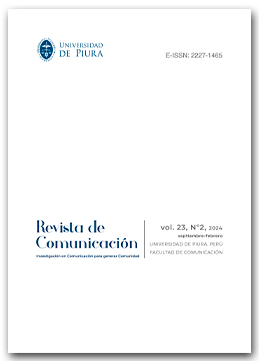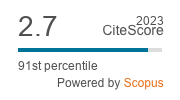Redefiniendo la Publicidad In-Game: una revisión sistemática de la literatura y una definición actualizada
DOI:
https://doi.org/10.26441/RC23.2-2024-3497Palabras clave:
videojuegos, advertainment, advergaming, publicidad in-game, publicidad around-game, emplazamiento de producto, definición, revisión sistemáticaResumen
Para construir un conocimiento válido y fiable es fundamental tener una definición precisa de los conceptos. La coherencia terminológica es esencial para utilizar un marco conceptual común, evitar ambigüedades y facilitar la comparabilidad de los estudios. Realizamos una revisión sistemática de la literatura para identificar y analizar las definiciones de publicidad In-Game (IGA) y una serie de entrevistas con profesionales de las industrias de la publicidad y los videojuegos para conocer la visión profesional del término. Se ha encontrado confusión en el uso de IGA y de conceptos relacionados pero diferentes, tanto en la literatura como en la práctica profesional. Por ello, presentamos un árbol de decisiones para facilitar una denominación coherente en el área de investigación del advertainment y resumimos toda la investigación en una redefinición de IGA que sintetiza y actualiza las anteriores: IGA es la integración de contenido persuasivo en los elementos jugables de un videojuego cuando el contenido ha sido creado para un anunciante real que no ha desarrollado el videojuego. Este es el primer estudio que utiliza un enfoque sistemático para definir el IGA. El árbol de decisión ayuda tanto a los estudiosos como a los profesionales a clasificar con claridad los términos críticos relacionados con el IGA (es decir, advertainment, advergaming, advergame, product placement, IGA, AGA).
Métricas
Citas
Adibi, F., Majidi, B., & Eshghi, M. (2018). Personalized advertisement in the video games using deep social network sentiment analysis. 2018 2nd National and 1st International Digital Games Research Conference: Trends, Technologies, and Applications (DGRC). DOI: https://doi.org/10.1109/DGRC.2018.8712072
Aliagas, I., Privado, J., & Merino, M. D. (2021). Proximity, familiarity or congruency? What influences memory of brand placement in videogames. Journal of Theoretical and Applied Electronic Commerce Research, 16(4), 811–827. https://doi.org/10.3390/jtaer16040046 DOI: https://doi.org/10.3390/jtaer16040046
Asociación Española de Videojuegos. (2019). La Industria de Videojuegos - informe anuario. Asociación Española de Videojuegos (AEVI), 53(9), 1689–1699.
Balasubramanian, S. (1994). Beyond Advertising and Publicity: Hybrid Messages and Public Policy Issues. Journal of Advertising, 23(4), 29–46. http://www.jstor.org/stable/4188949 DOI: https://doi.org/10.1080/00913367.1943.10673457
Bardzell, J., Bardzel, S., & Pace, T. (2008). Player Engagement and In-Game Advertising. OTO Insights. New Media Research. www.onetooneinteractive.com
*Bogost, I. (2007). Persuasive Games: The Expressive Power of Videogames. The MIT Press. https://doi.org/10.7551/mitpress/5334.001.0001 DOI: https://doi.org/10.7551/mitpress/5334.001.0001
*Borawska, A., Borawski, M., Biercewicz, K., Łatuszyńska, M., & Duda, J. (2020). On the effectiveness of using virtual reality games in social marketing. Procedia Computer Science, 176, 3047-3056. https://doi.org/10.1016/j.procs.2020.09.199 DOI: https://doi.org/10.1016/j.procs.2020.09.199
Cabré, M. T., & Castellví, M. T. C. (1993). La terminología: teoría, metodología, aplicaciones. Editorial Antártida/Empúries.
*Cauberghe, V., & de Pelsmacker, P. (2010). Advergames. Journal of Advertising, 39(1), 5-18. https://doi.org/10.2753/joa0091-3367390101 DOI: https://doi.org/10.2753/JOA0091-3367390101
Celtek, E. (2010). Advertising in games: Advergaming applications in the tourism industry. Advertising and Branding: Concepts, Methodologies, Tools, and Applications, 1083–1108. DOI: https://doi.org/10.4018/978-1-5225-1793-1.ch050
Chaiken, S., & Stangor, C. (1987). Attitudes and attitude change. In M. R. Rosenzweig & L. W. Porter (Eds.), Annual Review of Psychology, 38, pp. 575–630 DOI: https://doi.org/10.1146/annurev.ps.38.020187.003043
*Cianfrone, B. A., Trail, G. T., Zhang, J. J., & Lutz, R. J. (2008). Effectiveness of in-game advertisements in sport video games: An experimental inquiry on current gamers. International Journal of Sport Communication, 1(2), 195-218. https://doi.org/10.1123/ijsc.1.2.195 DOI: https://doi.org/10.1123/ijsc.1.2.195
Codina, E., & Depalle, A. (n.d.). ¿Cómo redactar definiciones y explicaciones de conceptos? - redac_especializada. Retrieved December 1, 2020 from https://bit.ly/3PwuSGv
Comscore (2018). Recaudación y espectadores del cine español, Ministerio de Cultura y Deporte. https://bit.ly/3LnUcel .
De Besse, Bruno. Terminological Definitions in Wright, Sue Ellen, & Gerhard Budin (1997). Handbook of Terminology Management, John Benjamins
de Certeau (1984). The practice of everyday life (S. Rendall, Trad.). University of California Press.
Desarrollo Español de Videojuegos. (2020). Libro blanco del desarrollo español de videojuegos.
DFC Intelligence. (n.d.). Global Video Game Consumer Segmentation. Retrieved November 21, 2020, from https://bit.ly/38D6hyT
Dillard, J. P. (2010). Persuasion. In C. R. Berger, M. E. Roloff, & D. R. Roskos-Ewoldsen (Eds.), The Handbook of Communication Science (2nd ed., pp. 203–218). SAGE. DOI: https://doi.org/10.4135/9781412982818.n12
Federación de Gremios de Editores de España. (2019). Memoria 2019. 1–15. https://bit.ly/3MxKszB
*Grace, L., & Coyle, J. (2011). Player performance and in game advertising retention. Proceedings of the 8th International Conference on Advances in Computer Entertainment Technology - ACE ’11. https://doi.org/10.1145/2071423.2071492 DOI: https://doi.org/10.1145/2071423.2071492
Guo, F., Ye, G., Hudders, L., Lv, W., Li, M., & Duffy, V. G. (2019). Product Placement in Mass Media: A Review and Bibliometric Analysis. Journal of Advertising, 48(2), 215–231. https://doi.org/10.1080/00913367.2019.1567409 DOI: https://doi.org/10.1080/00913367.2019.1567409
*Herrewijn, L., & Poels, K. (2011). Putting brands into play: How game difficulty and player experiences influence the effectiveness of in-game advertising. International Journal of Advertising, 32(1), 17-44. https://doi.org/10.2501/ija-32-1-017-044 DOI: https://doi.org/10.2501/IJA-32-1-017-044
Herrewijn, L., & Poels, K. (2014). Rated A for advertising: A critical reflection on in‐game advertising. En Handbook of Digital Games (pp. 305-335). Wiley. https://doi.org/10.1002/9781118796443.ch11 DOI: https://doi.org/10.1002/9781118796443.ch11
*Huang, J., & Yang, T. (2012). The Effectiveness of In-game Advertising: The Impacts of AD Type and Game/AD Relevance. International Journal of Electronic Business Management, 10 (1), 61-72.
*Hudson, S., & Hudson, D. (2006). Branded Entertainment: A New Advertising Technique or Product Placement in Disguise? Journal of Marketing Management, 22(5–6), 489–504. https://doi.org/10.1362/026725706777978703 DOI: https://doi.org/10.1362/026725706777978703
*Hussein, Z., & Wahid, N. A. (2017). Game-mediated experience: Does brand exposure changing users’ attitudes? Advanced Science Letters, 23(1), 550-553. https://doi.org/10.1166/asl.2017.7252 DOI: https://doi.org/10.1166/asl.2017.7252
Interactive Advertising Bureau (2010). Platform status report.” Game Advertising, available: https://bit.ly/3MzIWgA
Jones, J., & Simons, H., (2017), Persuasion in Society. 3rd ed. Routledge. DOI: https://doi.org/10.4324/9781315739816
*Kim, Y., & Leng, H. K. (2017). Effectiveness of In-game Advertisement: An Examination of Repetition Effect, Brand Familiarity and the Relationship Between Gaming Skills and Advertising Execution. Journal of Global Sport Management, 2(1), 42–64. https://doi.org/10.1080/24704067.2017.1281714 DOI: https://doi.org/10.1080/24704067.2017.1281714
Kretchmer, S. B. (2004). Advertainment: The evolution of product placement as a mass media marketing strategy. Journal of Promotion Management, 10(1-2), 37-54. https://doi.org/10.1300/j057v10n01_04 DOI: https://doi.org/10.1300/J057v10n01_04
*Kumar, V., & Mittal, S. (2020). Mobile marketing campaigns: practices, challenges and opportunities. International Journal of Business Innovation and Research, 21(4), 523. https://doi.org/10.1504/ijbir.2020.105996 DOI: https://doi.org/10.1504/IJBIR.2020.105996
*Lee, M., & Youn, S. (2008). Leading national advertisers’ uses of advergames. Journal of Current Issues & Research in Advertising, 30(2), 1-13. https://doi.org/10.1080/10641734.2008.10505243 DOI: https://doi.org/10.1080/10641734.2008.10505243
*Lorenzon, K., & Russell, C. A. (2012). From apathy to ambivalence: How is persuasion knowledge reflected in consumers’ comments about in-game advertising? Journal of Marketing Communications, 18(1), 55–67. https://doi.org/10.1080/13527266.2011.620768 DOI: https://doi.org/10.1080/13527266.2011.620768
Martí, J. (2013). Marketing y Videojuegos: Product Placement, In-Game Advertising y Advergaming. Boletín Científico de las Ciencias Económico Administrativas del ICEA. https://doi.org/10.29057/icea.v1i2.53 DOI: https://doi.org/10.29057/icea.v1i2.53
*Martínez, C. (2019). The struggles of everyday life: How children view and engage with advertising in mobile games. Convergence: The International Journal of Research into New Media Technologies, 25(5-6), 848-867. https://doi.org/10.1177/1354856517743665 DOI: https://doi.org/10.1177/1354856517743665
*Mau, G., Silberer, G., & Constien, C. (2008). Communicating brands playfully: Effects of in-game advertising for familiar and unfamiliar brands. International Journal of Advertising, 27(5), 827-851. https://doi.org/10.2501/s0265048708080293 DOI: https://doi.org/10.2501/S0265048708080293
Miller, G. R., (1980), On being persuaded: Some basic distinctions, in M. E. Roloff and M. E. Miller (Eds), Persuasion: New directions in theory and research. Sage. pp. 11–28
Nahai, N. (2017), Webs of influence: The psychology of online persuasion. Pearson Education Limited.
*Nelson, M., & Waiguny, M. (2012). Psychological Processing of In-Game Advertising and Advergaming: Branded Entertainment or Entertaining Persuasion? en Shrum, L. J. (Ed.), The Psychology of Entertainment Media. Routledge. https://doi.org/10.4324/9780203828588 DOI: https://doi.org/10.4324/9780203828588
Nelson, M., Yaros, R. A., & Keum, H. (2006). Examining the influence of telepresence on spectator and player processing of real and fictitious brands in a computer game. Journal of Advertising, 35(4), 87–99. https://doi.org/10.2753/JOA0091-3367350406 DOI: https://doi.org/10.2753/JOA0091-3367350406
Newzoo. (2022). 2022 Global Games Market Report. In Newzoo. https://bit.ly/3OXiDom
Niño, J. I., Cuesta, U., & Martínez, L. (2019). Publicidad in-game (iga): un análisis exploratorio de patrones de personalidad y de respuesta biométrica mediante expresión facial, GSR y Eye-Tracking. Revista Prisma Social, 26, 116–130.
Novak, T & Hoffman, D. (1997). New Metrics for New Media: Toward the Development of Web Measurement Standards. World Wide Web Journal, Winter Project. 2. 213-246.
Page MJ, McKenzie JE, Bossuyt PM, Boutron I, Hoffmann TC, Mulrow CD, et al. (2021). The PRISMA 2020 statement: an updated guideline for reporting systematic reviews. BMJ, 372 (71). doi: 10.1136/bmj.n71 DOI: https://doi.org/10.1136/bmj.n71
*Palmas, F., Reinelt, R., & Klinker, G. (2021). In-game advertising: Brand integration and player involvement as key influencing factors on brand recall. En Lecture Notes in Computer Science (pp. 352-367). Springer International Publishing. DOI: https://doi.org/10.1007/978-3-030-77277-2_27
Pavel, S., & Nolet, D. (2001). Handbook of terminology. Direction de la terminologie et de la normalisation, Bureau de la traduction.
Pillai, D., Balasubramanian, S.K., & Zanjani, S.H.A. (2014). The effect of individual level variables on the effectiveness of brand placements. Innovative Marketing, 10(4)
*Poels, K., Janssens, W., & Herrewijn, L. (2013). Play buddies or space invaders? Players’ attitudes toward in-game advertising. Journal of Advertising, 42(2-3), 204-218. https://doi.org/10.1080/00913367.2013.774600 DOI: https://doi.org/10.1080/00913367.2013.774600
Pons, J. V. (2006). Advergaming, cuestiones básicas. - ExeBlog, desarrollo de videojuegos y más. https://bit.ly/3sINBVc
*Raatikainen, O. (2012). Dynamic in-game advertising in 3D digital games a threat and a possibility. Nordicom Review, 33(2), 93–102. https://doi.org/10.2478/nor-2013-0016 DOI: https://doi.org/10.2478/nor-2013-0016
Real Academia Española. (n.d.b). definición. Diccionario de la Lengua Española. Retrieved November 19th, 2021 from https://bit.ly/38CPYST
Real Academia Española. (n.d.a). definir. Diccionario de la Lengua Española. Retrieved November 19th, 2021 from https://bit.ly/3Lpqq95
Redondo, I. (2012). The effectiveness of casual advergames on adolescents’ brand attitudes. European Journal of Marketing, 46(11), 1671–1688. https://doi.org/10.1108/03090561211260031 DOI: https://doi.org/10.1108/03090561211260031
Redondo, I., & Bernal, J. (2016). Product Placement Versus Conventional Advertising: The Impact on Brand Choice of Integrating Promotional Stimuli into Movies. Journal of Promotion Management, 22(6), 773–791. https://doi.org/10.1080/10496491.2016.1214205 DOI: https://doi.org/10.1080/10496491.2016.1214205
*Rodriguez, R., Arbaiza, F., & Yalan, E. (2021). Percepción de «gamers» universitarios de la UPC sobre el «in-game advertising» de Adidas en el videojuego «FIFA20». Index comunicación, 11(2), 21-40. https://doi.org/10.33732/ixc/11/02percep DOI: https://doi.org/10.33732/ixc/11/02Percep
Seibel, C., & Jiménez, C. (2009). Definir para todos. La definición como acceso fundamental a la información. Materiales multimedia para todos: Inclusión y accesibilidad en educación, 167–184. http://lexicon.ugr.es
Sartori, G. (1984). Guidelines for concept analysis. In Social science concepts: A systematic analysis. Sage Publications.
*Siemens, J. C., Smith, S., Fisher, D., Thyroff, A., & Killian, G. (2015). Level up! The role of progress feedback type for encouraging intrinsic motivation and positive brand attitudes in public versus private gaming contexts. Journal of Interactive Marketing, 32, 1-12. https://doi.org/10.1016/j.intmar.2015.07.001 DOI: https://doi.org/10.1016/j.intmar.2015.07.001
Sierra, R. (2005). Técnicas de investigación social. Teoría y ejercicios. 14a edición. Thomson.
Smit, E., van Reijmersdal, E., & Neijens, P. (2009). Today’s practice of brand placement and the industry behind it. International Journal of Advertising, 28(5), 37–41. https://doi.org/10.2501/S0265048709200898 DOI: https://doi.org/10.2501/S0265048709200898
*Smith, R., Kelly, B., Yeatman, H., Moore, C., Baur, L., King, L., Boyland, E., Chapman, K., Hughes, C., & Bauman, A. (2020). Advertising placement in digital game design influences children’s choices of advertised snacks: A randomized trial. Journal of the Academy of Nutrition and Dietetics, 120(3), 404-413. https://doi.org/10.1016/j.jand.2019.07.017 DOI: https://doi.org/10.1016/j.jand.2019.07.017
*Smith, M., Sun, W., Sutherland, J., & Mackie, B. (2014). Game advertising: a conceptual framework and exploration of advertising prevalence. The Computer Games Journal, 3(1), 95-124. https://doi.org/10.1007/bf03395948 DOI: https://doi.org/10.1007/BF03395948
Statista. (2021). Number of gamers worldwide by region 2021. (s/f). Retrieved on June 4th, 2023 from https://www.statista.com/statistics/293304/number-video-gamers/
Statista. (2023) Video Games - worldwide. (s/f). Statista. Retrieved on June 4th, 2023 from https://bit.ly/45Kovr2
Stephen, A. T., & Galak, J. (2012). The effects of traditional and social earned media on sales: A study of a microlending marketplace. SSRN Electronic Journal. https://doi.org/10.2139/ssrn.1480088 DOI: https://doi.org/10.2139/ssrn.1480088
*Terlutter, R., & Capella, M. L. (2013). The gamification of advertising: Analysis and research directions of in-game advertising, advergames, and advertising in social network games. Journal of Advertising, 42(2–3), 95–112. https://doi.org/10.1080/00913367.2013.774610 DOI: https://doi.org/10.1080/00913367.2013.774610
*Tham, S., & Perreault, G. (2021). A whale of a tale: Gaming disorder and spending and their associations with ad watching in role-playing and loot-box gaming. Journal of Gambling Issues, 46, 62–81. https://doi.org/10.4309/jgi.2021.46.5 DOI: https://doi.org/10.4309/jgi.2021.46.5
The Making of Adventureland. (2006). EDGE, 162, 104-107. DOI: https://doi.org/10.1016/S0035-3787(06)75171-2
*Toh, C. Y., & Leng, H. K. (2014). Demographic differences in recall and recognition rates of in-game advertisements. Journal of Direct, Data and Digital Marketing Practice, 15(3), 187–196. https://doi.org/10.1057/dddmp.2013.76 DOI: https://doi.org/10.1057/dddmp.2013.76
Tuten, T., & Solomon, M. (2013). Social Media Marketing. Pearson Education Limited.
Valero, E., & Alcina, A. (2015). Aspectos críticos de la formalización de características conceptuales en la definición terminográfica. Terminàlia, (11), 30-44.
Valsangiacomo, C. (2022). Clarifying and defining the concept of liquid democracy. Swiss Political Science Review, 28, 61– 80. https://doi.org/10.1111/spsr.12486 DOI: https://doi.org/10.1111/spsr.12486
*van Reijmersdal, E. A., Jansz, J., Peters, O., & van Noort, G. (2010). The effects of interactive brand placements in online games on children’s cognitive, affective, and conative brand responses. Computers in Human Behavior, 26(6), 1787-1794. https://doi.org/10.1016/j.chb.2010.07.006 DOI: https://doi.org/10.1016/j.chb.2010.07.006
*Vashisht, D., & Chauhan, A. (2017). Effect of game-interactivity and congruence on presence and brand attitude. Marketing Intelligence & Planning, 35(6), 789-804. https://doi.org/10.1108/mip-01-2017-0018 DOI: https://doi.org/10.1108/MIP-01-2017-0018
Vashisht, D., Mohan, H. S., & Chauhan, A. (2020). In-game advertising: the role of newness congruence and interactivity. Spanish Journal of Marketing-ESIC, 24(2), 213-230. https://doi.org/10.1108/sjme-02-2019-0012 DOI: https://doi.org/10.1108/SJME-02-2019-0012
*Verberckmoes, S., Poels, K., Dens, N., Herrewijn, L., & De Pelsmacker, P. (2016). When and why is perceived congruity important for in-game advertising in fantasy games? Computers in Human Behavior, 64, 871-880. https://doi.org/10.1016/j.chb.2016.07.062 DOI: https://doi.org/10.1016/j.chb.2016.07.062
Walsh, P., Zimmerman, M. H., Clavio, G., & Williams, A. S. (2014). Comparing Brand Awareness Levels of In-Game Advertising in Sport Video Games Featuring Visual and Verbal Communication Cues. Communication & Sport, 2(4), 386-404. https://doi.org/10.1177/2167479513489120 DOI: https://doi.org/10.1177/2167479513489120
*Wang, S. S., & Chou, H.-Y. (2019). Effects of game‐product congruity on in‐app interstitial advertising and the moderation of media‐context factors. Psychology & Marketing, 36(3), 229-246. https://doi.org/10.1002/mar.21174 DOI: https://doi.org/10.1002/mar.21174
Wüster, E. & Cabré, M. T. (2010). Introducción a la teoría general de la terminología y a la lexicografía terminológica. Girona, Documenta Universitaria. Retrieved from https://bit.ly/3Llr8Ek
*Yang, M., Roskos-Ewoldsen, D. R., Dinu, L., & Arpan, L. M. (2006). The effectiveness of “in-game” advertising comparing college students’ explicit and implicit memory for brand names. Journal of Advertising, 35(4), 143–152. https://doi.org/10.2753/JOA0091-3367350410 DOI: https://doi.org/10.2753/JOA0091-3367350410
*Yoon, G. (2019). Advertising in Digital Games: A Bibliometric Review. Journal of Interactive Advertising, 19(3), 204–218. https://doi.org/10.1080/15252019.2019.1699208 DOI: https://doi.org/10.1080/15252019.2019.1699208
Descargas
Publicado
Cómo citar
Número
Sección
Licencia
Derechos de autor 2024 Revista de Comunicación

Esta obra está bajo una licencia internacional Creative Commons Atribución-NoComercial-SinDerivadas 4.0.











 Portal de Revistas de la Universidad de Piura.
Portal de Revistas de la Universidad de Piura.